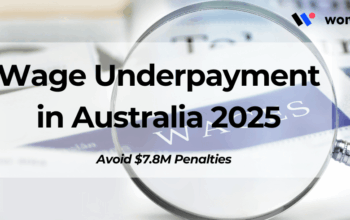Table of content
- Why is Payroll Compliance Critical for Legal Risk Management?
- Step 1: What Payroll Systems Should You Implement for Compliance?
- Step 2: When Should You Review and Update Pay Rates?
- Step 3: How Do You Ensure Accurate Superannuation Contributions?
- Step 4: Where Must You Focus Your Record-Keeping Efforts?
- Step 5: Who Needs Training on Compliance Requirements?
- Step 6: What Audit Procedures Protect Against Non-Compliance?
- Step 7: When Should You Seek Professional Compliance Support?
- Common Pitfalls to Avoid in 2025
- How Workstem Simplifies Payroll Compliance
- FAQs About Payroll Compliance
Navigating payroll compliance in 2025 requires a strategic approach to avoid severe legal consequences. With criminal penalties now enforced for wage theft and complex regulatory requirements, Australian employers need a clear roadmap. This practical guide outlines seven essential steps to ensure payroll compliance for Australian standards while protecting your business from legal risks.
Why is Payroll Compliance Critical for Legal Risk Management?
Payroll compliance failures can result in criminal charges, with penalties including up to 10 years’ imprisonment and fines reaching $7,825,000 for corporations. Beyond financial penalties, non-compliance damages reputation, employee trust, and business viability. Understanding and implementing proper compliance measures is now a fundamental business survival requirement.
Step 1: What Payroll Systems Should You Implement for Compliance?
Choose Comprehensive Payroll Software
Select software that automatically updates with regulatory changes and includes:
- Single Touch Payroll (STP) integration
- Award interpretation engines
- Automatic superannuation calculations
- Real-time compliance monitoring
Modern solutions like Workstem provide AI-powered engines that auto-calculate overtime pay, allowances, and more to comply with Fair Work & EBA requirements.
Establish Clear Processes
Document all payroll procedures, ensuring consistency across your organisation. This protects against accidental non-compliance and demonstrates good faith efforts.
Step 2: When Should You Review and Update Pay Rates?
Annual Review Schedule
- 1 July each year: Update minimum wage rates (currently $24.95 per hour)
- Quarterly: Review award changes and industry updates
- Monthly: Verify all employees receive at least minimum entitlements
Immediate Updates Required
Any Fair Work Commission decisions or legislative changes must be implemented from their effective dates. Delayed implementation constitutes wage theft under 2025 criminal laws.
Step 3: How Do You Ensure Accurate Superannuation Contributions?
Current Requirements
Payroll compliance in Australia mandates 12% superannuation guarantee from 1 July 2025. Key obligations include:
- Calculate on ordinary time earnings (OTE)
- Pay within 28 days after quarter end
- Include all eligible employees (including those earning less than $450 per month from 1 July 2022)
Verification Process
- Cross-check calculations monthly
- Confirm payments reach correct funds
- Maintain detailed contribution records
- Report through STP Phase 2
Step 4: Where Must You Focus Your Record-Keeping Efforts?
Essential Documentation
Payroll compliance requires maintaining records for seven years, including:
- Employee details and employment terms
- Time and wages records
- Leave records and accruals
- Superannuation contribution evidence
- Tax withholding documentation
Digital Solutions
Implement cloud-based storage with automated backup systems. This ensures record accessibility for audits while protecting against data loss.
Step 5: Who Needs Training on Compliance Requirements?
Comprehensive Training Program
Ensure these stakeholders understand payroll compliance obligations:
- Senior Management: Legal responsibilities and personal liability
- HR Teams: Current employment laws and entitlements
- Payroll Staff: Technical requirements and calculation methods
- Line Managers: Timesheet accuracy and approval processes
Regular Updates
Conduct quarterly training sessions covering regulatory changes. Document attendance to demonstrate compliance commitment.
Step 6: What Audit Procedures Protect Against Non-Compliance?
Internal Audit Schedule
Implement monthly mini-audits focusing on:
- Random sample of payslips for accuracy
- Superannuation payment confirmations
- Leave balance reconciliations
- Overtime and penalty rate calculations
External Verification
Engage professional auditors annually to identify gaps your internal processes might miss. This proactive approach prevents minor issues becoming major violations.
Self-Reporting Protocol
Establish procedures for identifying and reporting errors. The Fair Work Ombudsman offers cooperation agreements for employers who self-report, potentially reducing penalties.
Step 7: When Should You Seek Professional Compliance Support?
Warning Signs
Seek immediate professional help if you:
- Discover historical underpayments
- Receive employee complaints about pay
- Face Fair Work investigations
- Struggle with award interpretation
- Experience rapid business growth
Ongoing Support
Consider partnering with payroll compliance specialists or implementing comprehensive HR systems. Professional support ensures you stay current with evolving regulations.
Common Pitfalls to Avoid in 2025
-
Misclassifying Employees
Incorrectly classifying employees as contractors or casuals when they’re entitled to permanent benefits constitutes wage theft.
-
Ignoring Modern Awards
Each industry has specific award requirements. Generic minimum wage compliance isn’t sufficient if your industry award mandates higher rates.
-
Delayed Superannuation Payments
Missing quarterly deadlines incurs significant penalties and interest charges, plus potential criminal liability.
How Workstem Simplifies Payroll Compliance
Simplify award interpretation and payroll processing with Workstem, the all-in-one workforce management & payroll software designed for every industry. Our system supports 122+ modern awards & 34 EAs, and keeps you up-to-date with changes in wage rates, penalty rates, and overtime rules.Workstem offers:
- Automated award interpretation
- Real-time wage calculations and timesheet syncing
- Employee self-service app for rosters and payslips
- Seamless integrations with Xero, NetSuite, and more
Choose from our Standard or Advanced plan to suit your business needs, and stay Fair Work compliant with confidence.
Book a free demo with our payroll experts and experience how Workstem can streamline your payroll and workforce operations.
FAQs About Payroll Compliance
Q1: What’s the difference between civil and criminal penalties for payroll non-compliance?
A1: Civil penalties are financial fines for unintentional breaches. Criminal penalties, including imprisonment, apply to intentional underpayment from 1 January 2025.
Q2: How can small businesses ensure payroll compliance with limited resources?
A2: Invest in automated payroll software that handles payroll compliance Australia requirements. The cost is minimal compared to potential penalties.
Q3: What evidence do we need to prove compliance during an audit?
A3: Maintain detailed records including timesheets, payslips, superannuation statements, leave records, and employment contracts for at least seven years.
Q4: Can we correct past mistakes without facing criminal charges?
A4: Yes, if errors were genuine mistakes. Self-reporting to Fair Work Ombudsman and rectifying underpayments demonstrates good faith.
Q5: How often do payroll compliance requirements change?
A5: Major changes typically occur annually (July), but updates can happen anytime. Subscribe to Fair Work and ATO updates for real-time notifications.
Read More:
Small Business Payroll Compliance 2025: Avoid ATO Penalties
Australian Payroll Compliance 2025: Essential Guide for Employers








